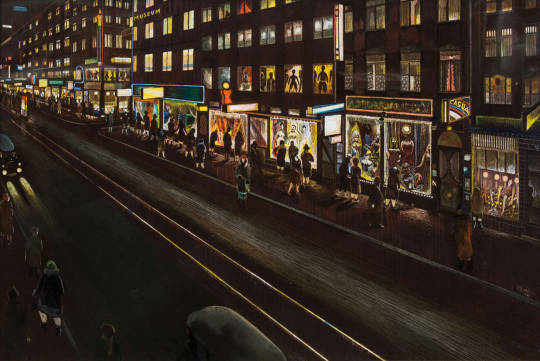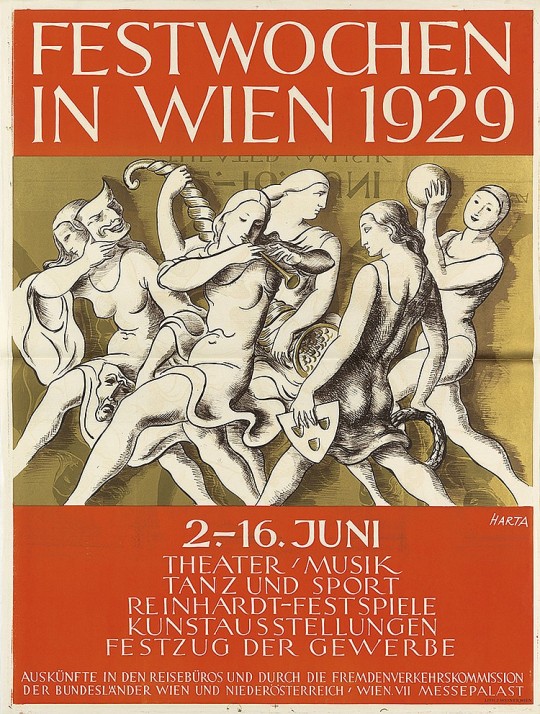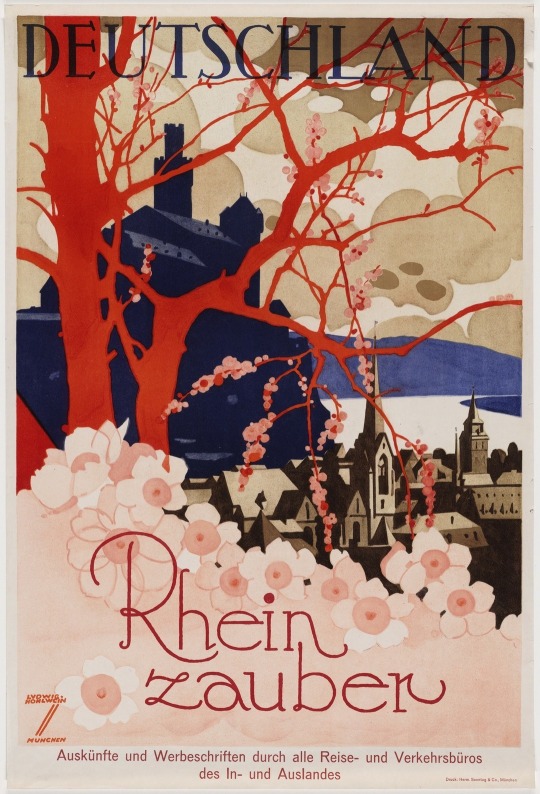Text

Conrad Felixmüller- Mondnacht/ Moonlit Night, 1920. Etching.
0 notes
Text

Arbeiten und nicht verzweifeln! (Work and do not despair!)
Titelseite der Zeitschrift "Der Blutige Ernst"
George Grosz, 1919
0 notes
Text

Stuttgarter Straße bei Nacht (Stuttgarter Str. at Night), 1931,
Reinhold Nägele (1884, Murrhardt - 1972, Stuttgart);
Reverse glass painting; 28,5x43 cm (source: veryimportantlot.com).
0 notes
Text

Felix Albrecht Harta, "Festwochen in Wien" ("Festival Week in Vienna"), 1929.
(Poster; 49.5 x 37.25 in. [125.7 x 94.6 cm.])
0 notes
Text

Werner Rohde (1906–1990), Portrait of Lore (Feininger), 1929, Gelatin silver print, 22.8 × 16.8 cm. Via MOMA.
The German portrait and architectural photographer Lore Feininger was the first daughter of the German-American painter Lyonel Feininger. In 1918, Lore Feininger began studying painting at the University for Fine Arts in Berlin. She then apprenticed with the portrait photographer Suse Byk, a family friend in Berlin. After three years of training, she worked in the studio of the fashion and portrait photographer Karl Schenker until 1924. In 1927, she opened her own photo studio for portrait, architectural, and object photography
0 notes
Text

Ludwig Hohlwein (German, 1874-1949) Poster, ca. 1929
Ludwig Hohlwein was a German poster artist, a pioneer of the Sachplakat style. He trained and practiced as an architect in Munich until 1911, when he moved to Berlin and switched to poster design
0 notes
Text

Robert Michel (German, 1897-1983), Lok (Höhenflug), (Locomotive - high altitude flight), ink and watercolour on detail paper 67 x 56.4cm (26 3/8 x 22 3/16in). Painted in 1923. Via Bonhams.
0 notes
Text

Arthur Benda (1885-1969), of the Atelier d'Ora, photographed the dancer, Gypsy Rhoumaje, in 1928, most likely when she spent that autumn performing in Vienna. Please click on the picture to see the whole thing. Born Dorothy Shaw in the US state of Arkansas - and rumored to be distantly-related to Ulysses S Grant - Shaw eventually moved to Los Angeles, where she billed herself as Hungarian or South American, re-named herself Gypsy Rhoumaje (there are multiple spellings), danced, appeared in a couple of films, and attracted the attention of a booking agent who brought her to London in 1926. Soon, she was dancing on major stages across Europe, including runs at Berlin's Wintergarten and La Scala. (Ullstein Bild)
0 notes
Text

Krupp-Werke, Engers am Rhein
(Krupp Works, Engers am Rhein)
Richard Biringer, 1925
0 notes
Text

Camilla Horn as Gretchen in FW Murnau’s FAUST. The 1926 silent film was Camilla Horn's breakthrough as an actress. She replaced the American Lillian Gish, who Murnau had initially tried to secure for the role of Gretchen. (Silent and Pre-Code Horror)
0 notes
Text

MARTEL SCHWICHTENBERG, 5 June 1896, Hannover - 31 July 1945, Sulzburg, German painter and graphic artist.
After studying at the Düsseldorf Academy of Art, she became an assistant to the architect Bernhard Hoetger in 1917, with whom she worked out the designs for the planned TET city of the Bahlsen works. The plans were never realized, but she stayed working for Bahlsen in the following years.
During the 1920s, she incorporated artistic influences of the expressionist bridge graphics into her work. Financially secured by a fixed contract with Bahlsen, she set up her own studio in Berlin-Charlottenburg in 1920, joined the Werkbund and the revolutionary November Group. In 1929 she took part in the exhibition "Die Frau von heute" (The woman of today), which was organized by the Berlin Verein der Künstlerinnen. In the same year she showed her works in New York and in the following years in the great Berlin galleries, e.g. at Flechtheim am Lützowufer.
In early 1933 she emigrated from Germany to South Africa. Despite the geographical distance she continued to work for the Bahlsen Works on a fee basis, got a large commission for murals in the House of Broadcasting in Johannesburg and captured her impressions in hundreds of watercolours.
Six years later the African dream ended tragically: In 1938 a fire devastated Schwichtenberg's home and studio, along with some 400 works storedthere, and during a private visit to Munich she was surprised by the outbreak of war, so that she could not leave the country again.
From then on the painter lived in the Black Forest, lived temporarily in a sanatorium, struggled with her depression and alcohol addiction, finally fell ill with cancer and died shortly after the end of the war.
Acrobats, Grotesque balancing act, around 1922
0 notes
Text

Friedrich Seidenstücker, "The "Normal Clock," at the Zoo station, a popular meeting point that brought it to literary fame during the years of the Weimar Republic, 1930.
(Alfred Gottwaldt, "Railway Focus Point Berlin," W. Coal Hammer, Mainz, 1982.)
0 notes
Text

Soldat und Nonne(Soldier and Nun), 1924,
Otto Dix, (1891-1969);
Etching and aquatint; 19.53 x 13.97 cm. (Via kettererkunst)
"Dix's War prints were published in 1924, the tenth anniversary of the outbreak of the war, as an antidote to the heroic interpretation of the war. [...] One of his prints, Soldat und Nonne ("Soldier and nun", K.120) - a graphic image of a soldier attempting to rape a nun -, was withdrawn from the series before it was published, but another Soldat und Hure ("Soldier and whore", K.105) was included under the title Besuch bei Madame Germaine in Méricourt ("Visit to Madame Germaine's in Méricourt")." Wikipedia, 'The War (Dix engravings)
1 note
·
View note
Text

OSKAR SCHLEMMER : "Konzentrische Gruppe - Figurenplan K1" (Concentring Group - Figure Plan K1) , 1921 . Lithograph on slightly colored paper ; 49 x 33,5 cm . From the portfolio New European Graphics . 1st portfolio : Masters of the State Bauhaus , Weimar .
Private Collection.
0 notes
Text

Eva
(plate, folio 63) from Ecce Homo
George Grosz, 1922-23
(original executed in 1918)
1 note
·
View note
Text

Lore Feininger (1901 - 1991), Kurt Schwitters with Ilse Vordemberge-Gildewart. Silver print, 12.7x17.1 cm. Via Swan Auctions.
Ilse Engelina Vordemberge, née Leda (born May 15, 1906 in Hanover; † August 2, 1981 in Rapperswil-Jona, Switzerland), was a German dance and gymnastics teacher. After her studies she opened her “School for Dance and Gymnastics” at Königstrasse 50a in Hanover. In 1930 the dance school moved to Sedanstrasse 47, where the parents' textile wholesale business was also located. A detailed report about Ilse Leda's school appeared in the special supplement of the Hannoverscher Anzeiger "Gymnastik & Tanz" from September 25, 1932. The prominent photographer of the report was Lore Feininger. Since 1925 she had been in contact with the Kestner Society's circle of friends, especially with Friedrich Vordemberge-Gildewart, whom she married on June 29, 1932 in Hanover. Kurt Schwitters, with whom the couple were good friends, also belonged to this circle of friends
0 notes
